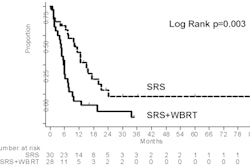
The researchers, from the University of New Mexico in Albuquerque and the University of California, San Francisco, have developed a delivery technique based on dose-painting, in which the Gamma Knife's spherical high-dose volume is used as a 3D "paintbrush" to paint a 3D tumor volume. The treatment-planning process essentially involves determining the best route of the paintbrush to deliver the prescribed dose (Physics in Medicine and Biology, March 2009, Vol. 54:6, pp. 1579-1591).
The dynamic delivery scheme was designed to exploit the robotic patient-positioning systems on the latest Gamma Knife units. "The beam focus point, where the spherical high-dose volume is located, is fixed. Thus, the only way to treat different points inside the patient is to move the patient," explained lead author Shuang Luan, Ph.D., from the University of New Mexico. "In order to move the patient continuously and precisely, we need the robotic positioning system."
Another drawback of the existing step-and-shoot approach is that there's currently no automated treatment-planning system for this technique, making it difficult and time-consuming to develop a high-quality plan. As a result, current Gamma Knife treatment is limited to a single isodose, hindering the usefulness of functional imaging techniques like MR spectroscopy that reveal high-tumor-burden areas where dose escalation could be beneficial.
To address this limitation, Luan and colleagues have developed a fully automatic inverse planning system for dynamic Gamma Knife radiosurgery. "Gamma Knife has always been considered the 'gold standard' for stereotactic radiosurgery. Sometimes, when a technology is so successful, a lot of people think it's perfect," Luan told medicalphysicsweb.
He continued: "For those physicists working in Gamma Knife centers, it has always been clear that current step-and-shoot Gamma Knife does have a few undesirable features. For example, before the introduction of the automated positioning system, physicists had to set up the patient manually. Dynamic delivery would greatly reduce the labor intensiveness of treatment planning because it is ideally suited for full automatic inverse planning. It may also improve treatment quality."
Automated approach
The researchers developed the inverse planning system around the Leksell Gamma Knife Perfexion system (Elekta, Stockholm, Sweden), which comprises eight sectors of built-in collimators, each of which can deliver shots 4, 8, and 16 mm in diameter (or be closed). The planning algorithm involves several key steps:
- A large set of potential shots is generated, based on the available amount of memory, using a hybrid approach that employs both deterministic (for larger tumors) and randomized selection methods.
- Iterative constrained least squares optimization is used to find the subset of shots that minimizes the difference between created and ideal dose distributions.
- The final route is calculated using the "traveling salesman" approximation algorithms, and a final dose calculation is performed on this route.
The team used the inverse planning algorithm to plan dynamic Gamma Knife radiosurgery for three simulated 3D phantoms: one with a spherical tumor, one with a C-shaped tumor, and one with a spherical critical structure surrounding a C-shaped tumor. In all phantoms, the skull was simulated as a sphere of radius 80 mm.
In all cases, the inverse planning system produced high-quality radiosurgery plans. The researchers point out that dynamic radiosurgery plans are more conformal than step-and-shoot plans due to the continuous motion during treatment. In the third phantom, the algorithm achieved a steep dose gradient (around 13% per mm) between the target and the adjacent critical structure.
The optimization process for a brain tumor takes minutes (using a MacBook Pro laptop computer). The algorithm also enables prescription of multiple isodose lines, enabling coverage of the periphery of the target volume while escalating the dose for high-tumor-burden regions. To increase the dose, the speed of the source is simply slowed as it passes through the target regions.
The dynamic Gamma Knife planning algorithm also offers the ability to create a family of plans that trade off delivery time against dose distribution, providing the clinician with the flexibility to choose a plan based on each clinical situation. Alternatively, the system can be given a fixed delivery time and it will automatically select a shot distribution that's suitable for the tumor size.
The researchers note that the dynamic scheme should enable Gamma Knife radiosurgery to be extended to anatomical sites outside the skull, and they plan to test it on sites including head and neck, spine, and prostate. They also plan to carry out more thorough testing of dynamic Gamma Knife radiosurgery using real clinical cases.
"Our original goals for developing dynamic Gamma Knife delivery were to reduce treatment time by taking advantage of the robotic patient positioning on the Gamma Knife C systems, and to develop a fully automatic inverse planning system," said Luan. "But once we started to work on the project, we started to think if Gamma Knife is so good, why can't we use it for other anatomical sites? With the introduction of the helmet-free Perfexion system, we felt this could be possible in future."
By Tami Freeman
Medicalphysicsweb science editor
March 23, 2009
Related Reading
Radiosurgery effective for vestibular schwannomas with neurofibromatosis type 2, February 6, 2009
Gamma Knife provides local control for some low-grade gliomas, December 23, 2008
Stereotactic radiosurgery can extend survival in small recurrent glioblastomas, June 20, 2008
Stereotactic radiosurgery improves survival after melanoma brain metastases, May 24, 2007
© IOP Publishing Limited. Republished with permission from medicalphysicsweb, a community Web site covering fundamental research and emerging technologies in medical imaging and radiation therapy.



















